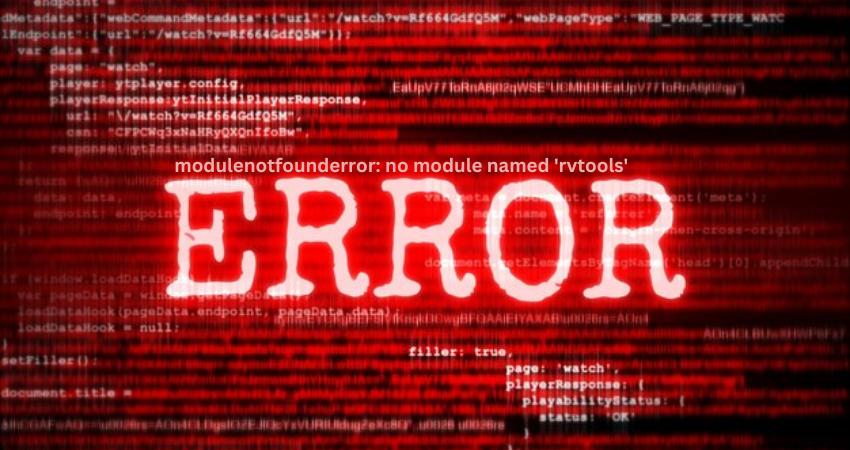In the vast landscape of coding, where lines of logic intertwine with dreams of creation, a whisper can halt the flow of progress—a whisper that says, modulenotfounderror: no module named ‘rvtools’. It’s not just an error; it’s a sigh from the machine, a pause in the dance of ones and zeros. But what does this mysterious message mean? Let’s embark on a journey to unravel the poetic truth behind this digital enigma.
The Prelude to a Heartbeat
Every piece of software, every script, is like a symphony. The modules are the instruments, each playing its part in harmony to create something beautiful. But when one instrument is missing, the symphony falters, leaving a void in the melody. The ‘rvtools’ module, in this case, is that missing instrument. Without it, the code cannot play its intended tune.
What is ‘rvtools’?
The Heartbeat of Python
In the world of Python, modules are the heartbeat of the language. They provide the necessary functions and classes that bring a program to life. When the Python interpreter searches for a module like ‘rvtools’ and finds nothing, it’s akin to a heart that misses a beat, causing a sudden pause—a reminder of the fragility of code.
The Echo of Absence

The Quest for the Missing Module
Finding the missing ‘rvtools’ is like searching for a lost star in the night sky. It requires patience, understanding, and a clear view of the heavens. The first step in this quest is to check if the module is installed. In Python, this can be done with a simple command
The Journey of Installation
The installation process is a journey in itself. When you run the above command, Python reaches out across the vast expanse of the internet to find ‘rvtools.’ If it exists in the repository, it will be downloaded and installed, like a traveler finally arriving at their destination.
The Roadblocks Along the Way
But what if the module cannot be found? What if the road is blocked? This could mean that ‘rvtools’ is not in the public repository, or perhaps there is a typo in the module name. It’s a moment of realization—a crossroads where the developer must decide which path to take.
The Art of Troubleshooting
Troubleshooting is an art, much like solving a puzzle. It requires intuition, logic, and sometimes a touch of creativity. When faced with a modulenotfounderror: no module named ‘rvtools’ the first step is to retrace your steps, to see where the code may have gone astray.
Checking the Pathways
The Python interpreter follows a set path to find modules. This path can be checked by printing out the system path:By understanding this pathway, a developer can see if the module is being searched for in the wrong place, like a traveler lost in a foreign city.
The Light of Virtual Environments
Sometimes, the problem lies not in the code, but in the environment. Virtual environments in Python create isolated spaces where modules can be installed. If ‘rvtools’ was installed in a different environment, the current script might not have access to it. Activating the correct environment can bring light to this shadowed problem.
The Dance of Dependencies
Modules often depend on other modules, creating a delicate dance of dependencies. If ‘rvtools’ relies on another module that is missing, the whole system can falter. Understanding these dependencies is like learning the steps of a complex dance, ensuring that each movement is in sync.
The Resolution: Bringing Back the Music
When the missing module is finally found and installed, it’s as if the symphony can begin again. The error message fades away, and the code can run smoothly, each line playing its part in the grand composition.
A Reflection on the Journey
The modulenotfounderror: no module named ‘rvtools’ is not just an obstacle; it’s a reminder of the delicate balance in coding. It’s a call to pay attention, to understand the deeper workings of the system. In solving this error, a developer grows, learning not just how to fix a problem, but how to listen to the silent messages within the code.

Conclusion: The Symphony Resumes
In the end, the ‘ModuleNotFoundError: No module named ‘rvtools” is just a pause in the music, a moment of silence that precedes the return of the melody. By understanding the cause and taking the necessary steps, the symphony of code can resume, each note in its rightful place, creating something beautiful once more.
FAQs
What is ‘rvtools’ used for?
‘Rvtools’ is a tool used in virtualization environments to extract and analyze data, providing insights and helping manage virtual machines more effectively.
How do I install ‘rvtools’ in Python?
You can install ‘rvtools’ using the pip command: pip install rvtools.
Why am I getting a ‘ModuleNotFoundError’ for ‘rvtools’?
This error occurs when the Python interpreter cannot find the ‘rvtools’ module, often due to it not being installed or not being in the correct environment.
How do I check if ‘rvtools’ is installed?
You can check by running pip show rvtools in your terminal. If it’s installed, this command will display information about the module.
What should I do if ‘rvtools’ is not in the repository?
If ‘rvtools’ is not found in the public repository, you might need to check for a typo in the name or look for alternative installation methods, such as from a source file.


